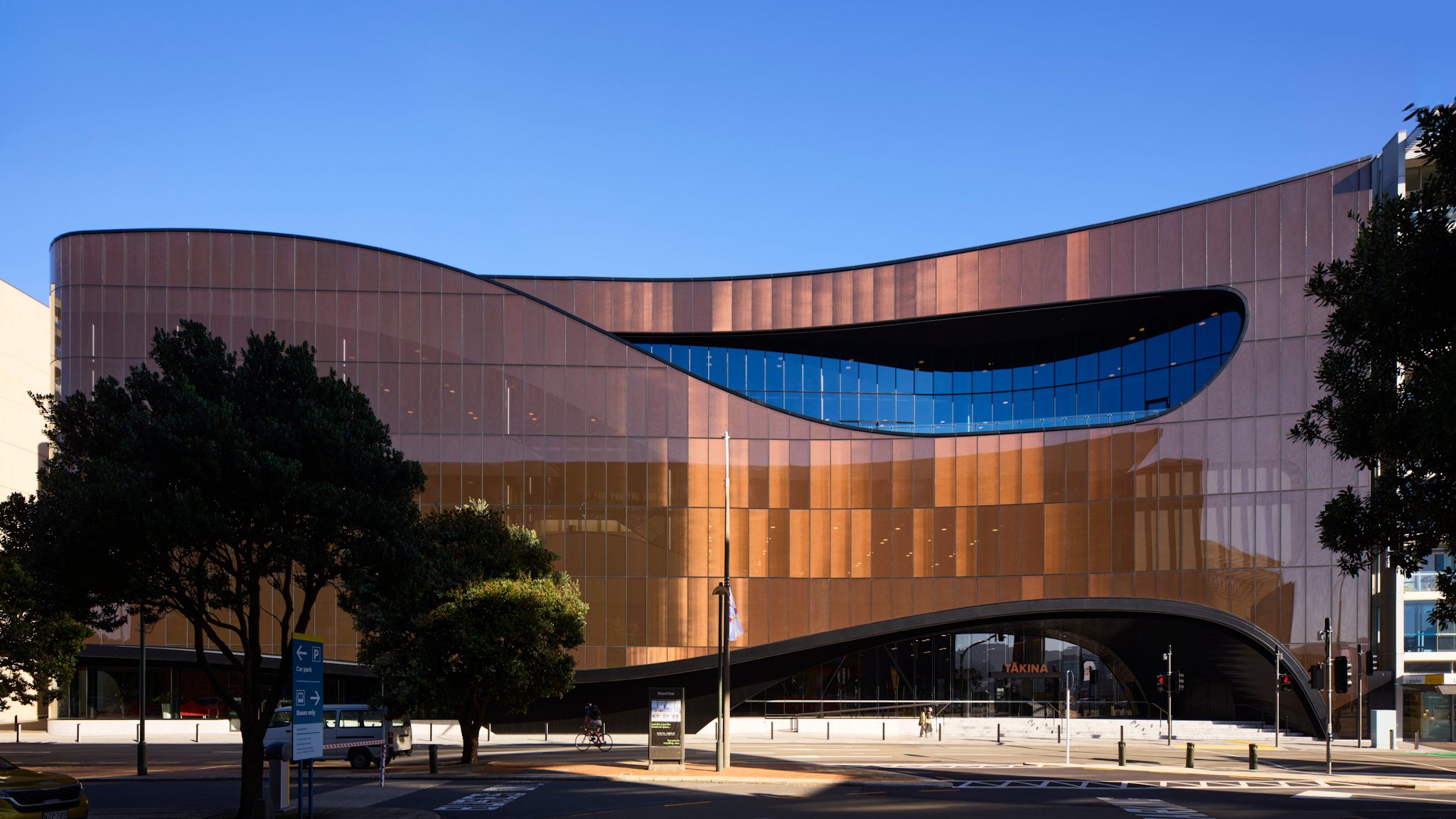Tākina is the first convention centre in Aotearoa to achieve both design and built 5 star Green Star ratings. It is a transformational green addition to Wellington’s cityscape.
Essentials
Name: Tākina Wellington Convention & Exhibition Centre
What: three level building; 18,000 square metres; ground floor has a public exhibition gallery, café, courtyard, public walkway; L1 and L2 have a range of flexible conference and meeting spaces
Where: 5500 square metre site opposite Te Papa Tongarewa and near the waterfront
Cost: $171 million
Annual visitor estimate: 500,000 people
Meaning of name: gifted by Taranaki Whānui, Tākina means to invoke, to summon, to connect and to bring forth. The name also references Wellington’s wind
Address: 50 Cable Street, Te Whanganui-a-Tara Wellington
Project Snapshot
Owner: Wellington City Council
Architect: Studio Pacific Architecture
Project GSAP: BECA
Building Services Engineer: BECA
Structural Engineer: Dunning Thornton Consultants
Main contractor: LT McGuinness
Development Manager: Willis Bond
Project timeline: construction commenced December 2019; completion 2023; official opening May 2023.
Project certification: 5 star Green Star Custom Design rating (April 2021); 5 star Green Star Custom Built rating (March 2024).
Once a cluster of car rental offices and carparks, now the location of the greenest civic building in Aotearoa, Tākina articulates the push for a low carbon capital city.
In mid-2019 existing buildings on the council-owned site were demolished to make way for Wellington’s largest built infrastructure investment in 20 years.
From the outset this was a significant-sized project with big ambitions around the delivery of a highly sustainable, statement building.
With its unique sculptural form drawing inspiration from its maritime location, local weather patterns and Māori mythology, Stephen McDougall project director from Studio Pacific Architecture says Tākina’s design is organic, dynamic and deeply-rooted in the city.
“It seamlessly blends functionality, sustainability, aesthetics and cultural significance – overall it sets a new standard for convention centres in Aotearoa.”
He says the brief for Tākina challenged Studio Pacific Architecture “to be striking and audacious – yet provide a design that was cost effective, buildable and designed to meet Wellington City Council’s low-carbon and sustainable aspirations for the city.”
Those council aspirations are documented in its Te Atakura – First to Zero blueprint – a pathway towards carbon zero status for the capital by 2050.
Wellington City Council economic development projects manager, Kiri Rasmussen says it was vital the project aligned with Te Atakura.
“The council’s aspirations fit closely with Green Star. It wants to lead in this area, to set an example for all new developments, to show a green building is energy efficient and achievable.”
She says with Tākina’s 5 Green Star target in place the council could access Green Bonds (via LGFA) to help finance the project – “just one of the broad-ranging benefits of Green Star.”
Beca associate building scientist and project GSAP, Ethan Duff says Tākina is big in scale but heats, cools and ventilates like a small building.
“The building services are dynamic. It can operate efficiently both when it’s full of visitors and when it’s quiet and empty between events, using energy only when and where needed. Systems can be dialled back in spaces where energy doesn’t need to be expended. A lot of attention went into ensuring the thermal envelope keeps the building comfortable so warmth is retained.”
He says Tākina is expected to operate at a low cost – a two year building tuning programme using BTune technology is underway to optimise energy and environmental performance and outcomes.
Ethan says in the context of 5 Green Stars Tākina “is a great example of lots of little things done well - above and beyond what is normally expected.”
The building is more resilient with its base isolation, more water efficient (30% less water consumption) with its rainwater harvesting system (30,000 litres) and materials have been carefully curated for responsibility and sustainability.
“This is the result of a careful and conscientious design and build programme and the project team and WCC setting ambitious, cost effective and achievable targets.”

The impact of that tightknit project team and its pursual of targets has been a powerful theme in Tākina’s 5 Green Star story.
Development manager Willis Bond says team members – across all disciplines – coordinated throughout the duration of the project to find ways to reduce the building’s carbon footprint.
Steps taken included:
- a diagrid steel superstructure
- reducing the building’s peak heating/cooling loads
- testing power layouts for the exhibition space to optimise power provision
- incorporating automatic load shedding to manage peak electricity demand
- detailed life-cycle cost-analysis studies – to inform the facade and building services systems
- building less - Tākina’s simple floor plate is configured to provide day-to-day efficiency and long-term adaptability
Willis Bond chairman Mark McGuinness says “the willingness of the Wellington City Council and the project team to work so proactively together to find the best possible outcomes has enabled this exceptional building to come to fruition.”
Green features include:
- re-use and de-contamination of previously developed land
- steps taken for potential on-site renewable energy generation via solar array in future
- environmentally preferable materials for improved indoor air quality
- improved pedestrian access from city to harbour
- excellent access to nearby public transport and pedestrian routes
Technical features include:
- enhanced thermal insulation and high-performance double glazing using SEFAR technology (a first for NZ); improved thermal comfort/energy efficiency; unique façade aesthetic
- predicted GHG emissions reduction of 66% compared to a reference building
- adaptable and demand-controlled air conditioning system
- energy modelling to optimise energy systems/controls - for a comfortable and efficient building
- display screens communicating real-time building sustainability metrics; water and energy consumption; carbon emissions
Innovation points include:
- Advanced Building Tuning - beyond traditional building tuning processes undertaken in Green Star
- staff well-being (during construction); on-site promotion of environmental sustainability/health/wellbeing/inclusivity
Images courtesy of Jason Mann Photography.
